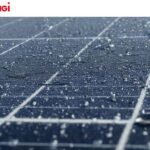Revolutionizing Urban Planning with Building-Integrated Photovoltaics
As the world grapples with the challenges of climate change, urban planning has become a critical aspect of creating sustainable cities. One innovative solution that's gaining traction is Building-Integrated Photovoltaics (BIPV). By harnessing the power of solar energy, BIPV is revolutionizing the way we design and build cities.
What is Building-Integrated Photovoltaics?
BIPV refers to the integration of photovoltaic (PV) systems into building design. Unlike traditional solar panels that are mounted on rooftops or in solar farms, BIPV systems are designed to be an integral part of the building envelope. This means that the PV system is incorporated into the building's façade, roof, or walls, providing a seamless and aesthetically pleasing solution.
According to the International Energy Agency (IEA), "BIPV systems can provide a significant portion of the building's energy needs, reducing the strain on the grid and lowering greenhouse gas emissions." "BIPV systems can provide a significant portion of the building's energy needs, reducing the strain on the grid and lowering greenhouse gas emissions."

The Benefits of BIPV in Urban Planning
So, why is BIPV becoming a game-changer in urban planning? Here are just a few reasons:
BIPV systems can provide a range of benefits, including:
- Reduced energy consumption and greenhouse gas emissions
- Increased energy independence and reduced reliance on the grid
- Improved building aesthetics and increased property values
- Enhanced building functionality and livability
- Opportunities for innovative urban design and planning
By incorporating BIPV systems into building design, cities can reduce their carbon footprint and create more sustainable, livable environments for residents.
Case Studies: BIPV in Action
Several cities around the world are already embracing BIPV as a key component of their urban planning strategies. Here are a few examples:
- In Barcelona, Spain, the city's "Superblock" program aims to reduce traffic congestion and promote sustainable urban development. As part of this initiative, several buildings have been designed with integrated BIPV systems, providing a model for future urban development.
- In Melbourne, Australia, the city's "Sustainable Buildings Program" has led to the development of several BIPV-integrated buildings, including the iconic Melbourne Cricket Ground.
- In Copenhagen, Denmark, the city's "CopenHill" waste-to-energy plant features a BIPV-integrated façade, providing a striking example of sustainable urban design.
These case studies demonstrate the potential of BIPV to transform urban planning and create more sustainable cities.
Overcoming the Challenges of BIPV
While BIPV offers many benefits, there are also several challenges to overcome. These include:
- Higher upfront costs compared to traditional solar panels
- Technical complexities and installation challenges
- Aesthetic and design considerations
- Energy efficiency and performance issues
However, as the technology continues to evolve and economies of scale improve, these challenges are becoming less significant.
The Future of BIPV: Emerging Trends and Innovations
So, what's next for BIPV? Here are a few emerging trends and innovations to watch:
- Building-integrated photovoltaic-thermal (BIPV-T) systems, which combine PV and thermal energy harvesting
- Thin-film PV technologies, which offer improved efficiency and reduced costs
- Building-integrated PV systems with energy storage, which enable greater energy independence and resilience
- Innovative urban design and planning strategies that incorporate BIPV systems
As these trends and innovations continue to evolve, we can expect to see even more exciting developments in the world of BIPV.
Finding Inspiration in Unlikely Places
As we explore the innovative world of Building-Integrated Photovoltaics, it's fascinating to consider how the principles of sustainable design can be applied to other areas of our lives. Take, for example, the concept of "energy harvesting" – the idea of capturing and utilizing energy from our surroundings to power our daily activities. This concept can be seen in action in some unexpected places, such as online games that incorporate elements of chance and probability to create an engaging experience. In fact, some games even use algorithms that mimic the unpredictability of renewable energy sources, like solar and wind power. Try your hand at Monopoly Lunar New Year slot online demo (Light & Wonder), a game that challenges players to balance risk and reward in a dynamic, fast-paced environment. As we strive to create more sustainable cities and communities, it's intriguing to think about how the principles of BIPV might be applied to other areas of our lives, from entertainment to education.
Conclusion
Building-Integrated Photovoltaics is revolutionizing urban planning and creating sustainable cities of the future. By harnessing the power of solar energy, BIPV systems can provide a range of benefits, from reduced energy consumption and greenhouse gas emissions to improved building aesthetics and increased property values. As the technology continues to evolve and economies of scale improve, we can expect to see even more widespread adoption of BIPV in urban planning.





